 Weed Grow Guide by Royal Queen Seeds
Weed Grow Guide by Royal Queen Seeds
- Growing weed step by step
- Marijuana growing basics
- Choosing your seeds
- How to germinate seeds
- The marijuana vegetative stage
- The marijuana flowering stage
- Harvesting marijuana
- Trimming, drying, and curing
- Choosing pots and soil
-
Growing indoors
- A Complete Overview Of Growing Cannabis Indoors
- Cannabis Cultivation Tips: How To Set Up Indoor Grow Lights
- How Many Cannabis Plants Can You Grow Per Square Metre?
- Indoor Cannabis Growing: Relative Humidity and Temperatures
- Hydroponics Cannabis Growing Guide (with diagrams)
- Cannabis Micro Growing: Growing Great Weed in Tiny Spaces
- Growing outdoors
- How to grow autoflowering marijuana
- Marijuana nutrients and pH
- Marijuana troubleshooting: Nutrients
-
Marijuana troubleshooting: Growing
- Cannabis Seed Germination — Troubleshooting Guide
- How to Deal With Pythium (Root Rot) in Cannabis Plants
- Slow Cannabis Plant Growth And What You Can Do About It
- How to Prevent and Fix Stretching in Cannabis Seedlings
- Watering Your Cannabis: How to Fix Overwatering and Underwatering
- Understanding Male, Female, And Hermaphrodite Cannabis
- Identifying and Treating Common Cannabis Ailments
- How To Revive a Sick Cannabis Plant
- How to Avoid Moldy Marijuana During Drying and Curing
- How to Prevent and Treat Dry and Crispy Cannabis Leaves
- What Cannabis Leaves Can Tell You
- Causes and Solutions for Yellow Cannabis Leaves
-
Marijuana Strains Grow Report
- HulkBerry Automatic Grow Report
- Blue Cheese Auto Grow Report
- Purple Punch Automatic Grow Report
- Triple G Automatic Grow Report
- Do-Si-Dos Automatic Grow Report
- Green Gelato Automatic Grow Report
- Haze Berry Automatic Grow Report
- Purple Queen Automatic Grow Report
- Cookies Gelato Automatic Grow Report
- Sherbet Queen Automatic Grow Report
- Sweet Skunk Automatic Grow Report
- Medusa F1 Grow Report
- Marijuana plant training
-
Marijuana growing tips
- The Cannabis Plant Anatomy
- How to preserve seeds
- How Much Sunlight Do Outdoor Cannabis Plants Need To Grow?
- How to Control and Prevent Stretching in Cannabis Plants
- My Cannabis Plants Are Growing Too Tall: What Should I Do?
- Should You Worry About Purple Or Red Cannabis Stems?
- What To Do When Your Indoor Cannabis Won’t Flower
- How To Protect Your Cannabis Plants From Heat Stress
- How To Tell If Your Female Cannabis Plant Has Been Pollinated
- Growing Medical Marijuana
- Bud Washing: How to Clean Your Weed
- Understanding Cannabis Yield per Plant

How Many Cannabis Plants Can You Grow Per Square Metre?
Factors that determine how many plants you can grow per square metre.
Contents:
Before you get started with your indoor grow operation, you need to have a plan. Among the things you need to think about is how many cannabis plants you can feasibly fit in your grow space.
FACTORS THAT DETERMINE THE NUMBER OF CANNABIS PLANTS YOU CAN GROW
Several factors influence the number of plants you can reasonably fit per square metre, from the available space in your grow room, to the size of your pots and the type of lights you're using.
The best approach is to use rectangular planting pots, especially if you want to grow more plants per square metre and take full advantage of your available growing area. With round planting pots, you'll be wasting valuable space.
CANNABIS STRAIN GENETICS
The first thing to consider is the type of cannabis you’re growing—the strain genetics. Sativas tend to grow tall, while indicas are stocky and bushier. Autoflowers grow particularly short, with some varieties reaching only 1.6 – 2 feet.
Even those without significant spatial limitations tend to choose shorter cannabis varieties when growing indoors. After all, you are responsible for providing illumination, so you need to account for the space taken up by your grow lights. Moreover, if you’re growing different strains and some end up being much taller than others, this can deprive smaller specimens of light, resulting in stretching and reduced final yields.
If you don’t plan on training your plants, consider growing the same type of strain, or two strains with very similar heights, to avoid running into issues with spacing and lighting. Of course, the smaller and more compact your plants, the more you can fit per square metre. It’s up to you to decide if you’d rather crop several small autoflowers or just one or two ultra-vigorous hybrids.
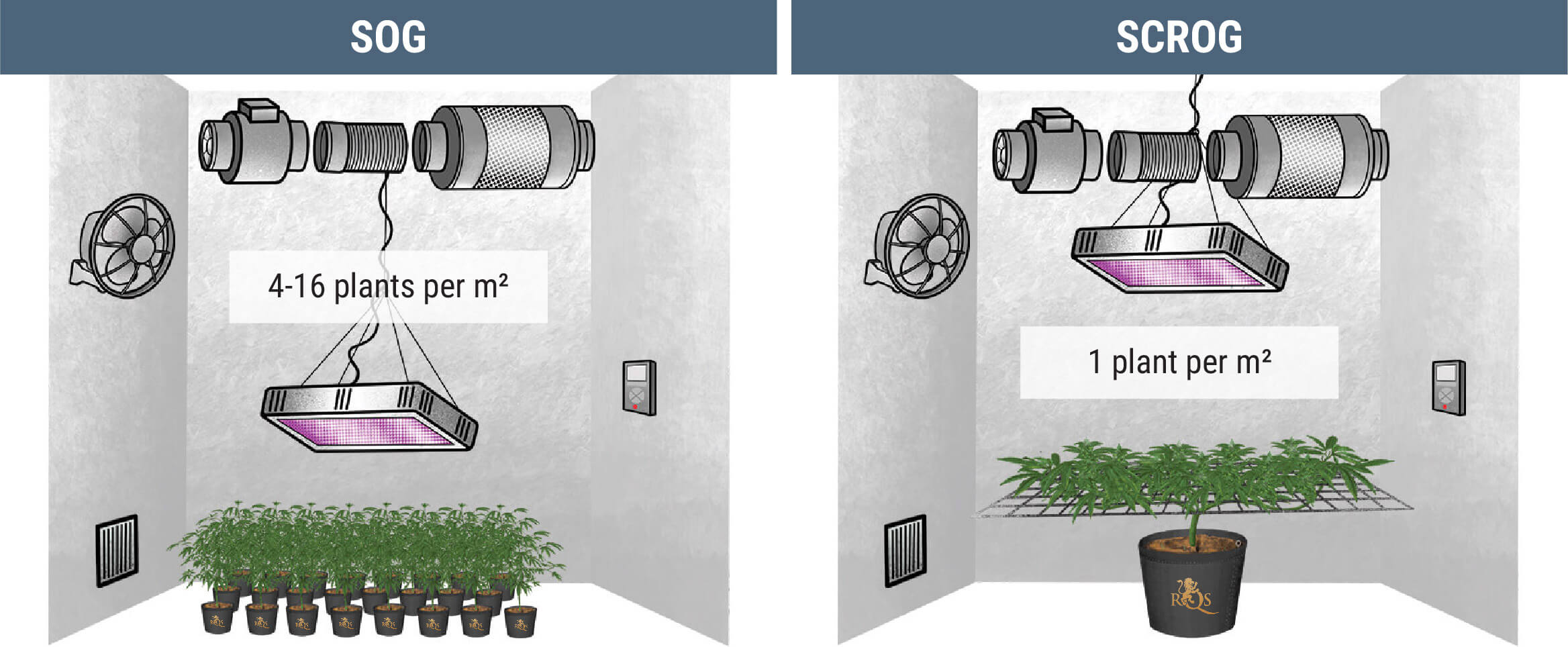
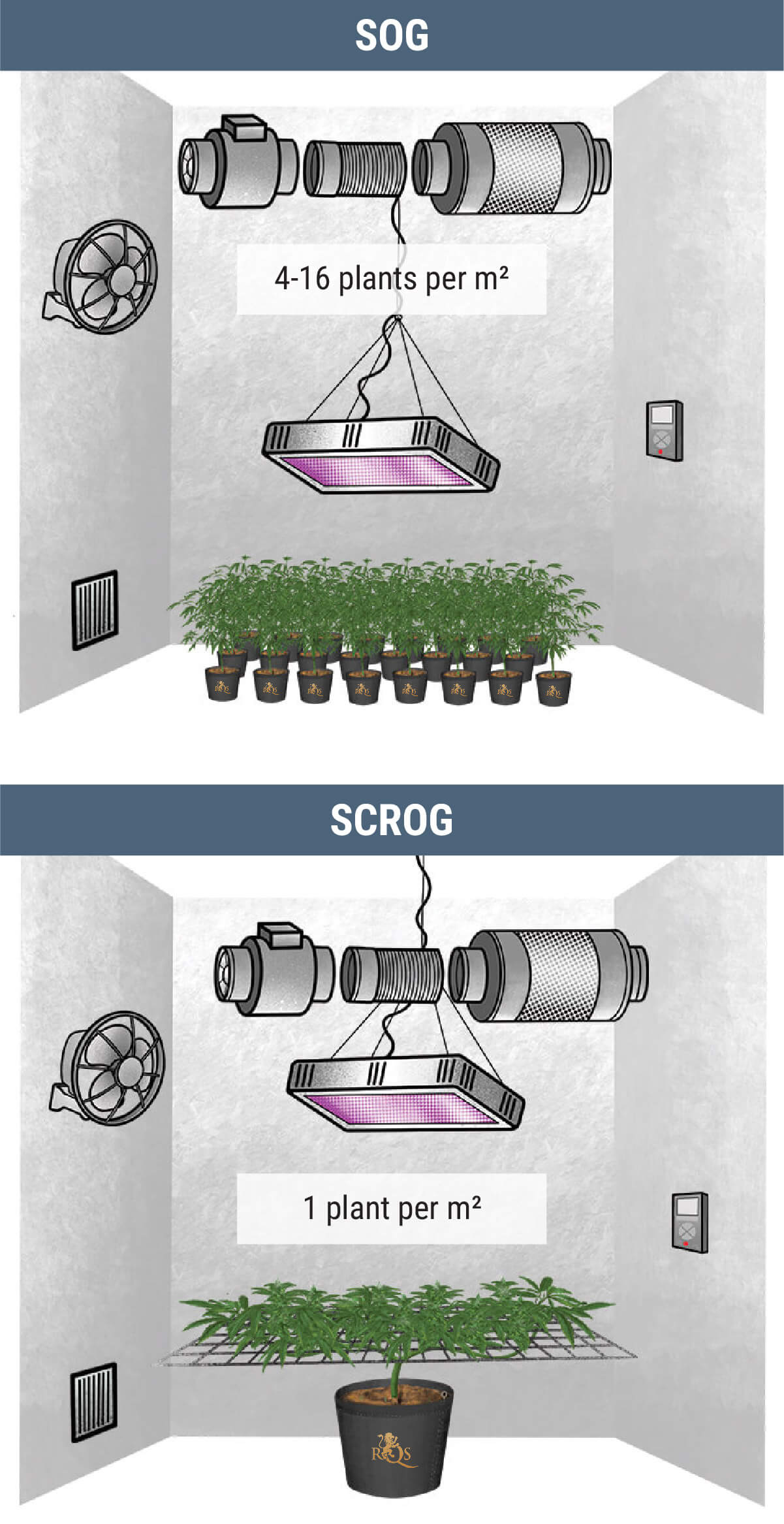
THE SIZE OF YOUR INDOOR GROW
The dimensions of your growing area will largely dictate how many plants you can grow per square metre, and in general. If you’re like most home growers, you’ll likely be using a grow tent set up in a suitable location in your home.
Grow tents are available in many different sizes, from small 1.6 × 1.6 feet tents to large ones that could fill half your room. The right size depends on what strain(s) you’re growing, how large your indoor growing space is, and what type of grow you are going for (heavy training, leaving plants to develop as is, etc.).
Explore all available grow tent sizes in our store to find the perfect fit for your setup.
As an example, if you just want to grow a single untrained photoperiod indica plant, a 1 × 1m tent should be sufficient. As you add more plants, you’ll need to scale up accordingly. But again, don’t just account for the eventual size of the plants themselves, but also lighting, ventilation, and other equipment.
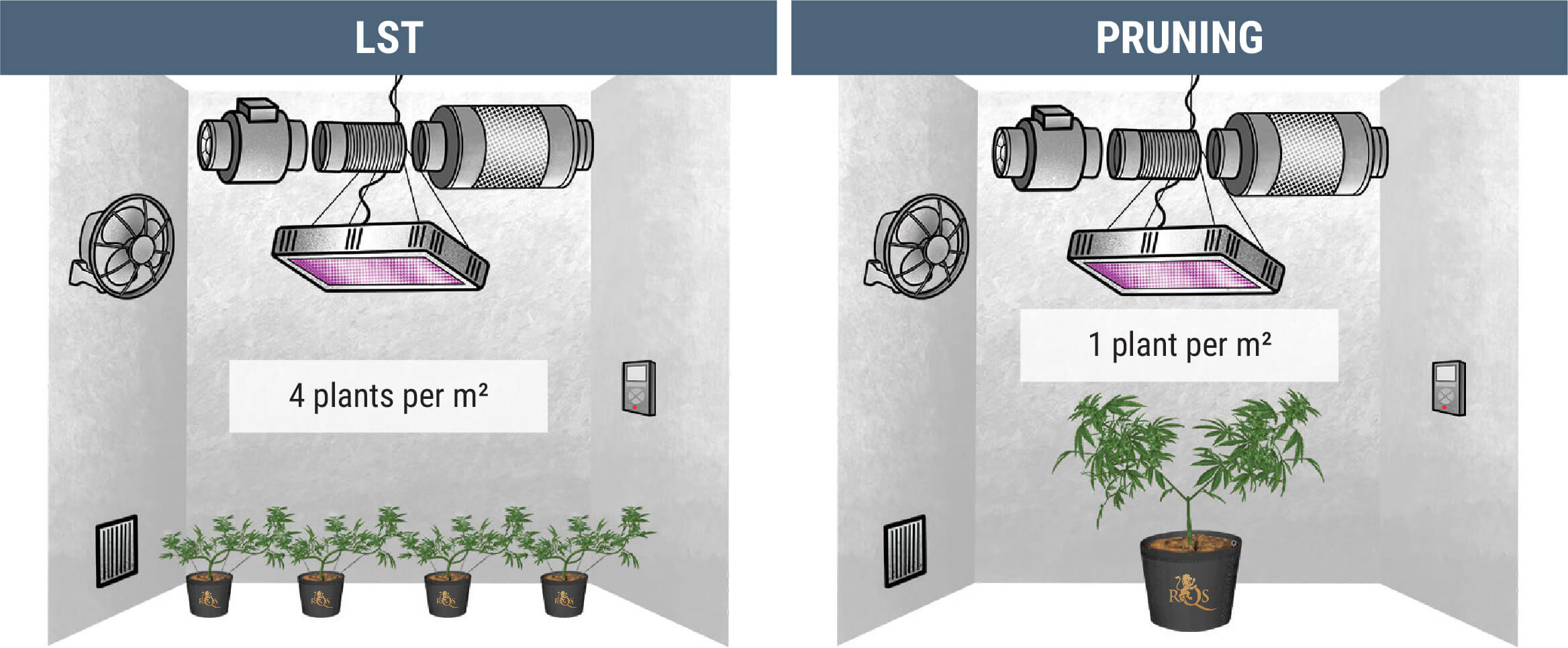
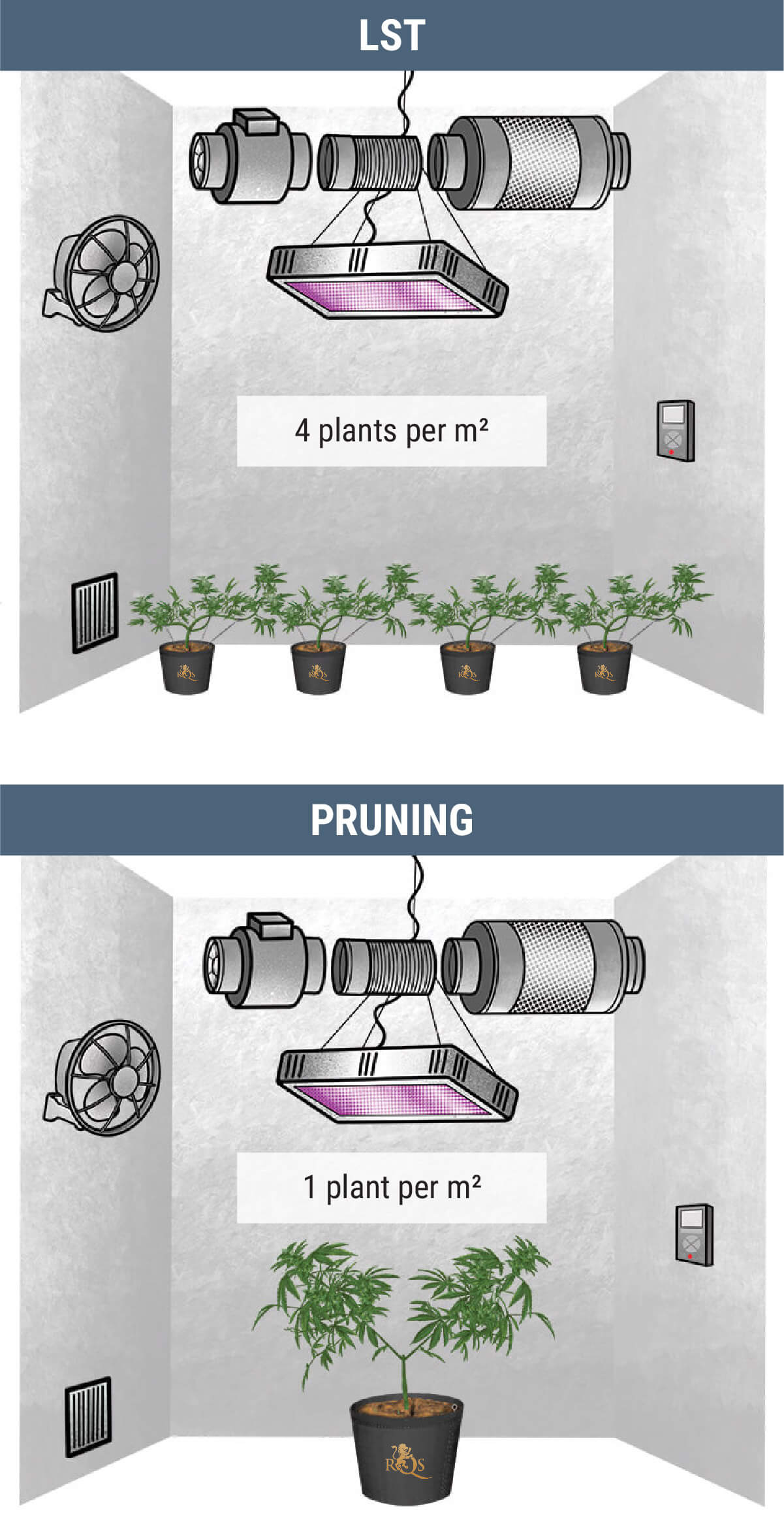
THE SIZE OF YOUR POTS
Depending on the diameter of your pots, several can fit into one square metre. But the size of your containers doesn’t just impact how many plants can fit per square metre, but also how big the plants will get overall. Said differently: The larger your pots, the bigger your plants will get.
Recommendations for pot sizes:
• ½ litre: Seedlings and young plants up to ~5.9 inches
• 2–3 litres: Plant height up to ~9.8 inches
• 5 litres: Plant height up to 23.4 inches
• 11 litres and more: Average plant height (check strain description)
For the average indoor grow, you can fit nine 11-litre pots per square metre.
Use rectangular planting pots to fully take advantage of your available growing area. With round planting pots, you’ll be wasting valuable space.
See our planting pot calculator to find the optimal pot size for your cannabis plants.
TRAINING YOUR PLANTS
With plant training techniques, you can keep the number of cannabis plants to a minimum while maxing out their potential. Each of these training techniques is designed to optimise space and increase yields.
SEA OF GREEN (SOG)
• 4–16 plants per square metre
• Outcomes: Fast yield, keeps plants short, easy to perform, comparatively smaller yields per plant
The sea of green method (SOG) is all about getting the most out of your available floor space. It is a good way to achieve a consistent outcome with photoperiod plants, clones, and autoflowers. This technique is fast and profit-yielding.
In a SOG, plants only get 1–2 weeks of vegetative growth before they are forced to switch to flowering. No pruning or training is needed. As the plants don’t have time to branch out, the result is many short plants with short main colas.
Under a 400W HPS light, you can fit 4–16 plants per m² in 5–12l containers. An optimal SOG grow can deliver multiple 17.6 oz/m² harvests per year.

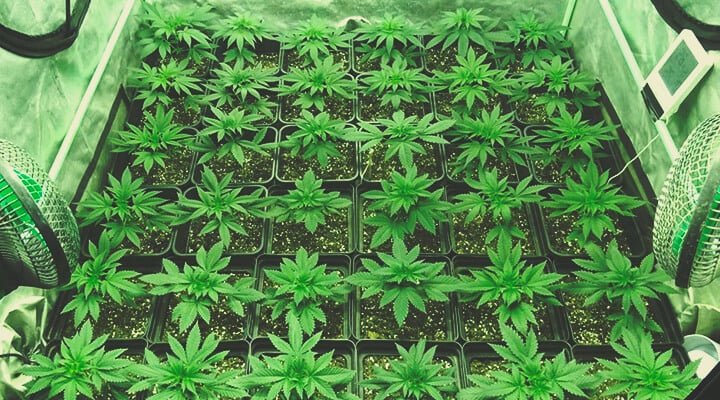
TOPPING AND FIMMING
• 2 large/5–10 small plants per square metre
• Outcomes: Simple to perform, keeps height in check, boosts yield, prolongs growth phase
Topping and fimming are high-stress training methods. By cutting off or pinching the main growing tip, you break the apical dominance of a plant so it develops multiple main colas instead of just one. This naturally results in bushier growth and causes plants to stop growing in their characteristic Christmas tree shape.
Any high-stress training technique that involves damaging your plants (like both topping and fimming) slows down growth and extends the vegetative phase.
If you’re pruning, topping, and/or fimming, allow your plants to recover and expect a later harvest date. Don’t overdo it; top or FIM 2–3 times per growing season.

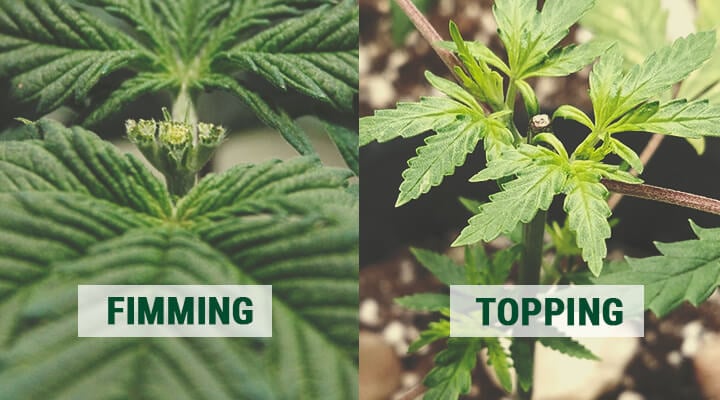
MAINLINING AND LOLLIPOPPING
• 1 large/2–4 small plants per square metre
• Outcomes: Challenging to perform, consistent results, options for beginners and more advanced growers
Mainlining and lollipopping are two plant training techniques that promote the growth of large buds at the ends of branches.
• Mainlining
Mainlining is a mix of topping, LST, lollipopping, and ScrOG. Plants are topped at the third node, with all the lower branches cut. This causes new growth to develop equally from one central hub, and plants are often topped a second or third time to develop multiple colas and an even canopy. This can fill up your grow space significantly depending on how many colas and the size of your pots, so keep in mind you may be able to fit fewer mainlined plants per square metre.

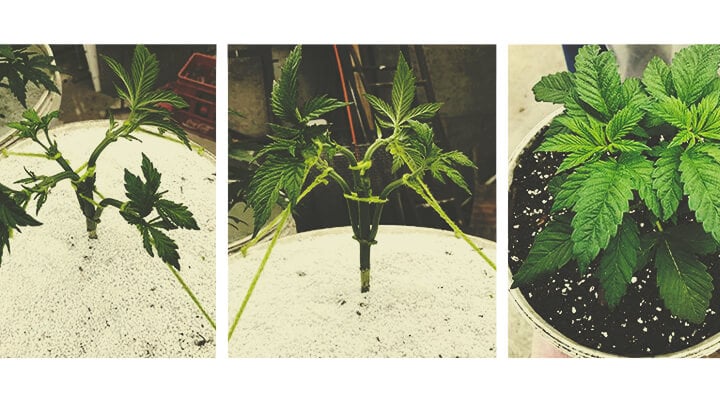
• Lollipopping
Lollipopping is complementary but can be done on untrained plants too. All branches—including the main stem—are trimmed of unnecessary growth, leaving only the main bud and side branches with large buds. Just as with mainlining, the plant now directs energy toward the large buds.

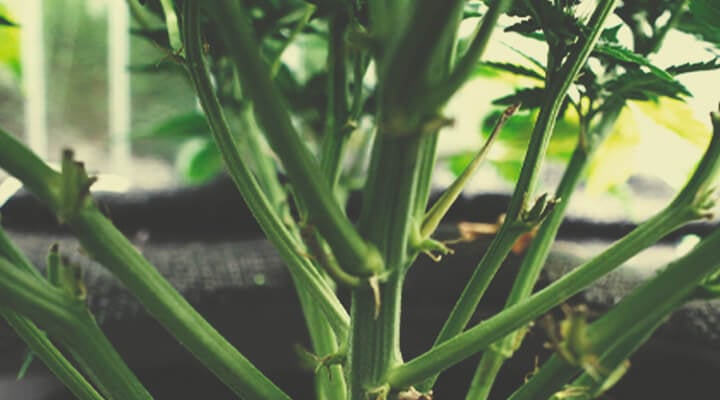
LOW-STRESS TRAINING (LST)
• 2–4 large/4–6 medium plants per square metre
• Outcomes: Suitable for autoflowers (no topping needed), best for beginners, requires no major recovery time
LST is a beginner-friendly training technique. You’re essentially just bending and tying down stems during vegetative growth to manipulate plants into growing horizontally. LST can be combined with other techniques, such as ScrOG. It is often done together with topping to break apical dominance, but it can also be performed without topping on autoflowers. Between 2–4 plants trained with LST can effectively fill 1m².

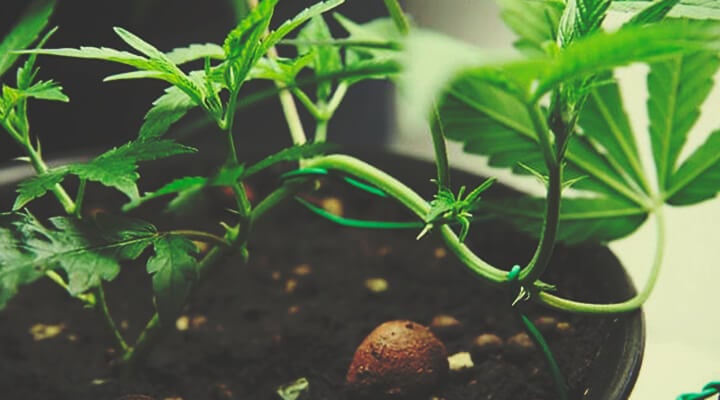
SCREEN OF GREEN (SCROG)
• 1–2 large plants/4 medium-sized plants per square metre
• Outcomes: Best yield per square metre, flexible with how many plants you want to use, for advanced growers only
A ScrOG is the best way to utilise a single square metre of growing space. In this advanced training method, the screen is a grid-like mesh (chicken wire, netting, etc.) through which shoots of developing cannabis plants are woven to control growth. Growers usually start weaving their ScrOG during the vegetative phase and end it before the third week of bloom.
A ScrOG keeps only the main colas under the light so the plant’s energy goes toward bud production. Top your plants early to get more branches, then proceed to train them in multiple directions through the screen. This way, you can get the maximum yield from your available growing space.
You can choose how many plants/pots you use for a ScrOG. You could fill your space with only one monstrous plant in a large 20l pot, but you could also grow several smaller plants, such as four medium-sized plants each in a 10l pot.

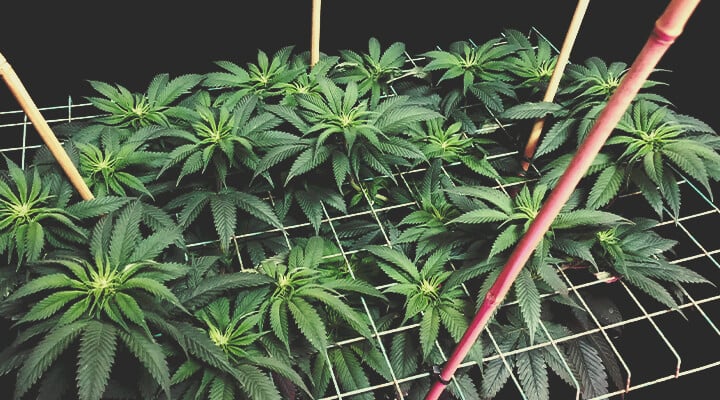
THE GROW LIGHTS YOU USE
The last factor that determines how many plants you can fit into each square metre of your grow space is the type, and intensity, of your grow lights. This becomes ever-more clear when you realize that grow lights don’t spread light evenly across the entire area.
The greatest light intensity (and thus the fattest buds) is right underneath the light, then decreases significantly toward the sides. This could make growing fewer plants more sensible, as you’ll probably be sacrificing yield to poor light spread if you cram in too many. There’s no point in depriving any of your plants.
If you’re growing weed with HID (high-intensity discharge) lights, a simple formula can give you a rough estimate for the recommended number of plants. Divide the wattage of your light by 75 and round up the fractions.
GUIDELINES FOR NUMBER OF PLANTS UNDER HID LIGHTING
- 150W HID ÷ 75 = 2 plants
- 250W HID ÷ 75 = 3.3 or 4 plants
- 400W HID ÷ 75 = 5.3 or 6 plants
- 600W HID ÷ 75 = 8 plants
- 1000W HID ÷ 75 = 13.3 or 14 plants
When using CFLs, divide by 150. For example, using a 400W CFL: 400W ÷ 150 = 2.6 or 3 plants
LED GROW LIGHTS
Modern LEDs can output the same light intensity as HPS units, while using around 60-70% of the energy. Therefore, they cover the same space in less wattage. A good 250W LED is equal to a 400W HPS, which can cover around 5–6 plants. By comparison, a high-powered 1200W LED should be able to cover around 8–9 plants.
However, keep in mind that wattage is only one value to consider when it comes to determining the power of your LEDs, as many other variables—including the type of LED—impact their effectiveness too.
When using LEDs, it is best to consult the manufacturer for the recommended number of plants to grow and the optimal distance from your lights to your plants' canopy. Reputable manufacturers usually make this type of information available.
- PRO TIP: If uncertain about how many plants you want to grow, it's always better to keep it "safe" with fewer plants. Two large but happy plants with fat buds will ultimately be better than a tent full of small, light-starved cannabis that will only yield mini buds. In addition to that, you'll also save on seeds.
Don’t Forget to Monitor the Environment
The size of your plants depends a lot on the environment too. For example, a higher light intensity leads to shorter plants, while a lower light intensity has the opposite effect, impacting bud sites and the final yield.
Significant temperature differences between day and night temperatures also impact plant development, resulting in taller plants with weaker stems and branches. Moreover, fluctuations in temperature and humidity could lead to a higher volume of water in plants. While this might lead to taller plants with larger leaves, flowers end up fluffy and loose.
Check a VPD chart to get better control of your plant's development. If you're struggling to juggle temperature and humidity in your grow room, it might be better to cultivate a maximum of four plants per square metre.
 Grow Guide Topic Finder
Grow Guide Topic Finder
- Growing weed step by step
- Marijuana growing basics
- Choosing your seeds
- How to germinate seeds
- The marijuana vegetative stage
- The marijuana flowering stage
- Harvesting marijuana
- Trimming, drying, and curing
- Choosing pots and soil
-
Growing indoors
- A Complete Overview Of Growing Cannabis Indoors
- Cannabis Cultivation Tips: How To Set Up Indoor Grow Lights
- How Many Cannabis Plants Can You Grow Per Square Metre?
- Indoor Cannabis Growing: Relative Humidity and Temperatures
- Hydroponics Cannabis Growing Guide (with diagrams)
- Cannabis Micro Growing: Growing Great Weed in Tiny Spaces
- Growing outdoors
- How to grow autoflowering marijuana
- Marijuana nutrients and pH
- Marijuana troubleshooting: Nutrients
-
Marijuana troubleshooting: Growing
- Cannabis Seed Germination — Troubleshooting Guide
- How to Deal With Pythium (Root Rot) in Cannabis Plants
- Slow Cannabis Plant Growth And What You Can Do About It
- How to Prevent and Fix Stretching in Cannabis Seedlings
- Watering Your Cannabis: How to Fix Overwatering and Underwatering
- Understanding Male, Female, And Hermaphrodite Cannabis
- Identifying and Treating Common Cannabis Ailments
- How To Revive a Sick Cannabis Plant
- How to Avoid Moldy Marijuana During Drying and Curing
- How to Prevent and Treat Dry and Crispy Cannabis Leaves
- What Cannabis Leaves Can Tell You
- Causes and Solutions for Yellow Cannabis Leaves
-
Marijuana Strains Grow Report
- HulkBerry Automatic Grow Report
- Blue Cheese Auto Grow Report
- Purple Punch Automatic Grow Report
- Triple G Automatic Grow Report
- Do-Si-Dos Automatic Grow Report
- Green Gelato Automatic Grow Report
- Haze Berry Automatic Grow Report
- Purple Queen Automatic Grow Report
- Cookies Gelato Automatic Grow Report
- Sherbet Queen Automatic Grow Report
- Sweet Skunk Automatic Grow Report
- Medusa F1 Grow Report
- Marijuana plant training
-
Marijuana growing tips
- The Cannabis Plant Anatomy
- How to preserve seeds
- How Much Sunlight Do Outdoor Cannabis Plants Need To Grow?
- How to Control and Prevent Stretching in Cannabis Plants
- My Cannabis Plants Are Growing Too Tall: What Should I Do?
- Should You Worry About Purple Or Red Cannabis Stems?
- What To Do When Your Indoor Cannabis Won’t Flower
- How To Protect Your Cannabis Plants From Heat Stress
- How To Tell If Your Female Cannabis Plant Has Been Pollinated
- Growing Medical Marijuana
- Bud Washing: How to Clean Your Weed
- Understanding Cannabis Yield per Plant













































